What Is a Content Outline?
A content outline is a document that details what an article should include. It serves as a framework for the completed piece.
Content outlines typically include the following elements:
- Title (H1): The title or headline of the article
- Main sections/headings (H2): These are the major divisions of your content. Each section represents a different aspect or subtopic related to the main theme. Headings provide a clear indication of the content’s structure. And help guide the reader through the material.
- Subsections (H3–H6): Within each main section, subsections further divide the content into more focused topics. Subsections help organize the information. And make it easier for readers to navigate.
- Key points: Important points that will be discussed within each section or subsection. Bullet points are often used to highlight key information.
- Supporting evidence/examples: Relevant evidence, data, statistics, or examples that support the key points. Supporting evidence adds credibility to the content. And helps reinforce the main ideas.
- References/citations: If applicable, include a list of sources in relevant outline sections. This allows writers and editors to reference and fact-check sources. And add external links.
Why Are Content Outlines Important?
- Organization: Outlines provide a structured framework for organizing information. They help you arrange your thoughts in a logical sequence. And ensure the content flows smoothly from one point to the next.
- Clarity: Outlines help you clarify ideas. And identify the main points of your content. By breaking down the content into smaller sections, you can double-check that each point is clear and well-defined.
- Focus: Outlining key points can help you avoid getting sidetracked by irrelevant information. And stay within the recommended word count.
- Communication: Content outlines can also serve as communication tools. Allowing you to share ideas with others. And gather feedback from editors before beginning the full writing process.
Content Outline vs. Content Brief
- Content brief: Provides a high-level overview of the content’s goals, target audience, key messaging, keywords, competitor analysis, and tone.
- Content outline: A structured breakdown of the content, including headings, subheadings, and main points to be covered. Serving as a roadmap for the content creation process.
Preliminary Steps Before Drafting Your Outline
Identify Your Target Audience
It’s important to understand your intended audience. So your content connects with them.
Follow these steps to learn more about your target audience:
Search Intent
Search intent is the goal or intent behind the search query or keyword you’re targeting.
There are four types of search intent:
- Informational: The user wants to learn something
- Navigational: The user is looking for a specific site
- Commercial: The user is comparing solutions
- Transactional: The user is ready to complete an action. Like purchasing.
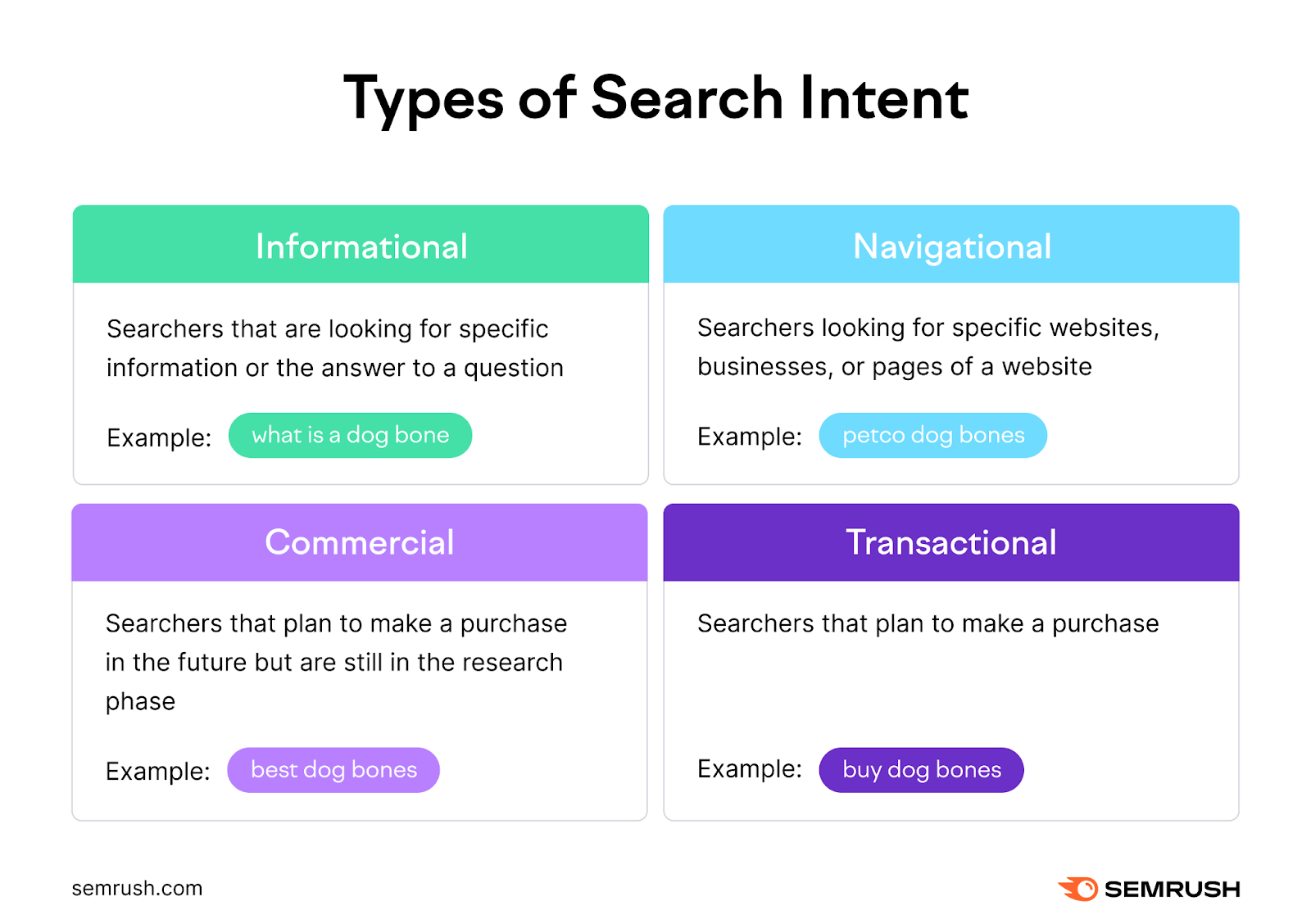
If your content doesn’t match search intent, users are likely to leave your page.
Knowledge Level
Will your content cater to readers with beginner, intermediate, or expert knowledge?
Knowledge level influences what information you include. And the level of detail. Like whether you should define a concept. Or assume the reader is familiar with it.
If your target audience is highly technical or academic, adapt your word choices accordingly.
Geography
When writing for global audiences, avoid culture-specific idioms and expressions. These can make your content confusing.
If your content targets a single country or region, consider including local expressions. To build trust and engagement with readers.
Marketing Funnel
Is your content aimed at a reader who is simply looking for information? Or are they getting ready to spend money?
Each marketing funnel stage is related to search intent and knowledge level.
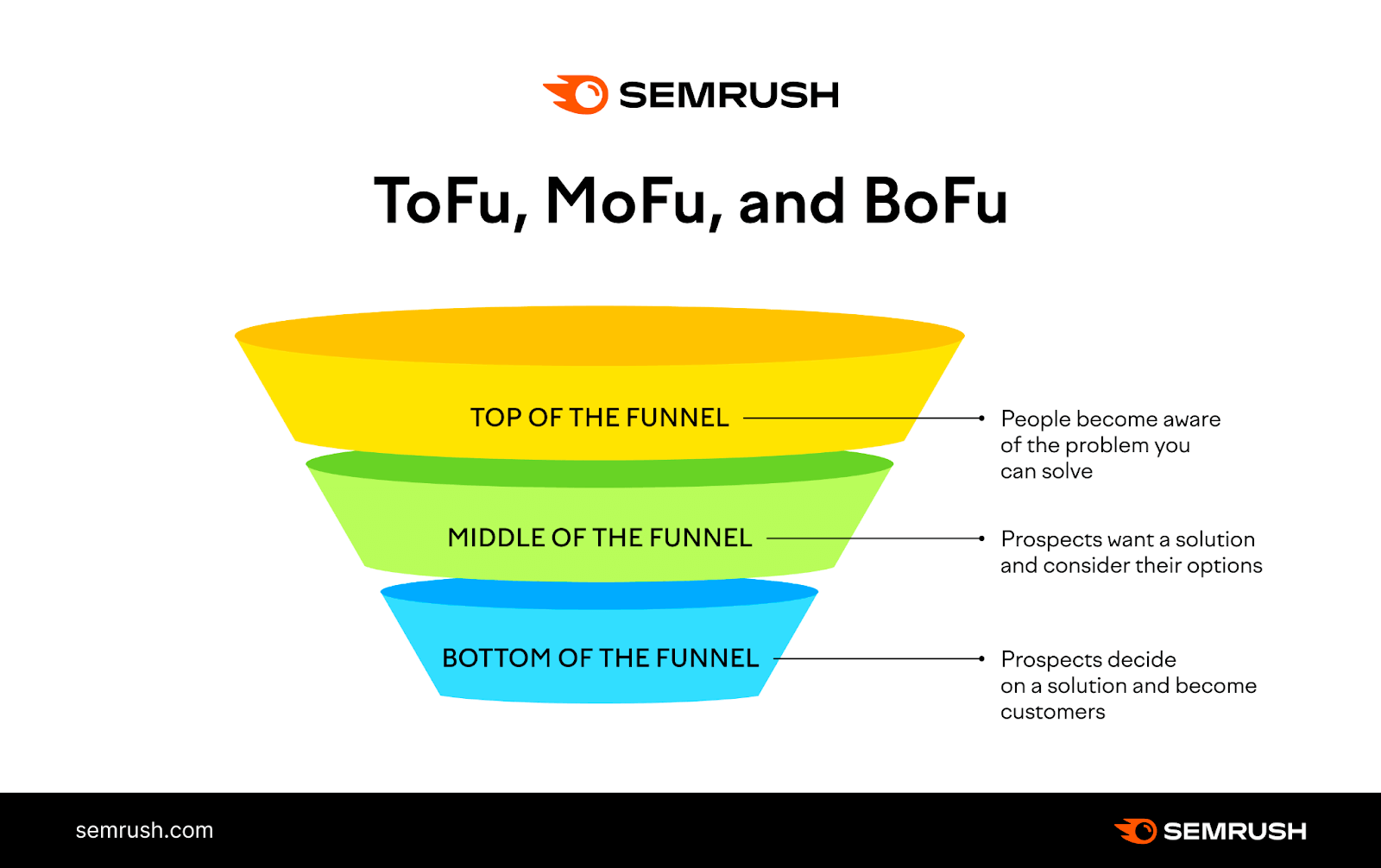
Failing to consider your audience can result in content that misses the mark. Meaning it’s not relevant to the reader. Or doesn’t meet their expectations.
Further reading: How to Create a Customer Profile (+ Free Templates)
Set Clear Objectives for Your Content
Before creating your outline, define your content’s main goal or objective. Identifying what you want to achieve with the content will help you choose the best approach.
Be more specific than “build brand awareness” or “increase organic website traffic.”
Here are some examples of content objectives:
- Rank in the top 10 search engine result pages (SERP) for your target keywords
- Earn backlinks from reputable sites in your niche
- Call attention to a specific product, feature, or service
- Serve as PR for a product, service, or brand
- Generate leads. Like downloading an asset, joining a mailing list, completing a form or survey, or registering for a webinar.
- Convert readers by including relevant calls to action (CTAs)
- Encourage social sharing
Research Keywords
It’s helpful to identify target keywords before creating a content outline.
Why? Because it can help guide the type of content you create. Like product pages for transactional intent. And an explainer article for informational intent. And the subtopics you include.
Choose a Target Keyword
Aim for a keyword that balances decent search volume (how many people search for the term each month) with an achievable keyword difficulty (KD) score. KD tells you how hard it’ll be to rank for each term on a scale of zero to 100. With 100 being the most difficult.
Use our Keyword Magic Tool to identify relevant keywords.
Enter your seed keyword in the search bar, select your audience location, and click “Search.”
For example purposes, we used “aromatherapy.”

When the report is ready, you’ll see a variety of keywords related to your search term.
To narrow your search, filter by the following:
- Search intent (“Intent”)
- Search demand (“Volume”)
- Keyword difficulty (KD%)
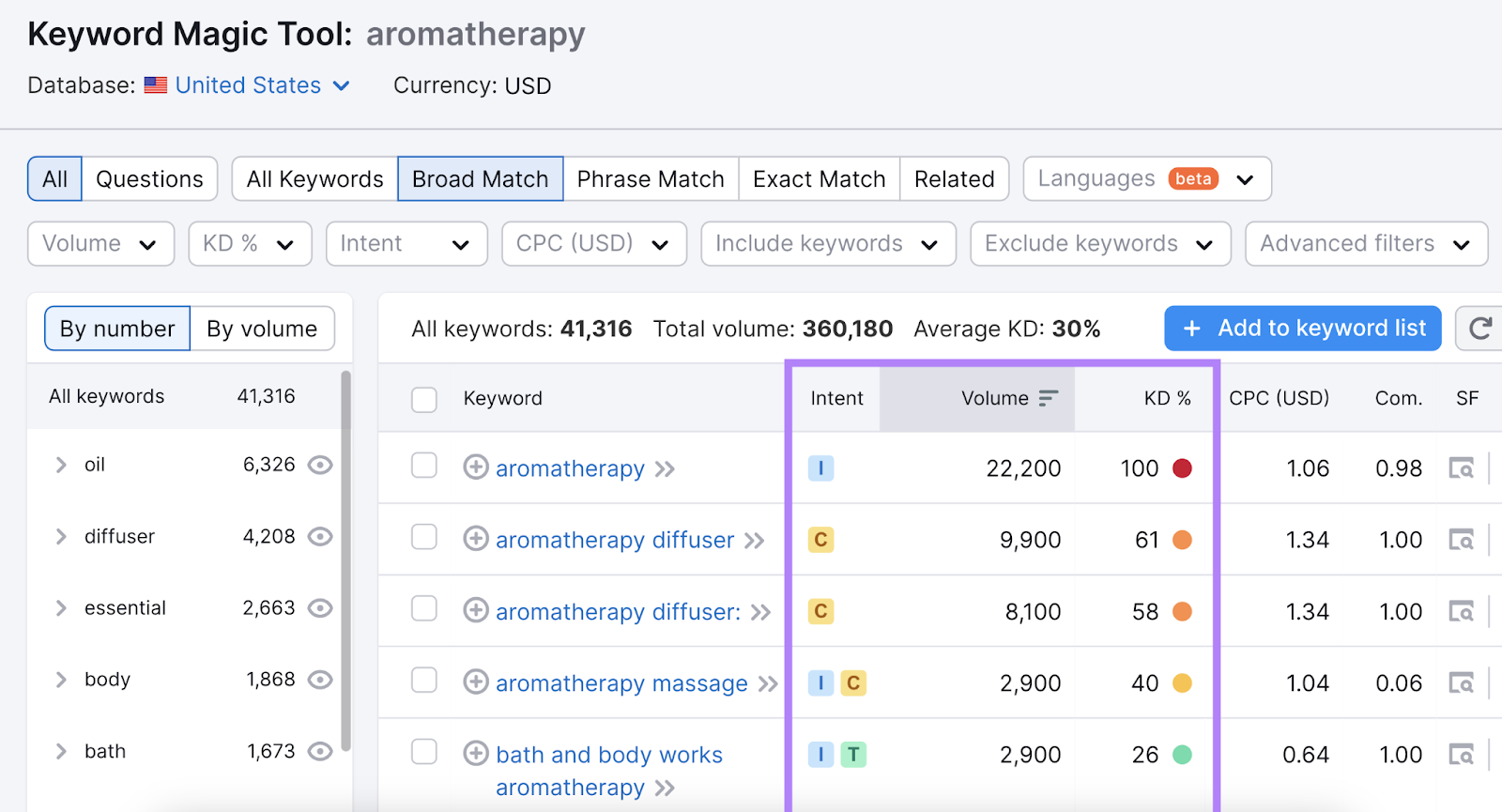
For example, you might look for a keyword that has an “Easy” or “Very Easy” keyword difficulty score. And decent search volume and informational intent.
Long-tail keywords can also help improve topic coverage. And help your content rank.
Long-tail keywords are highly specific search queries that tend to have relatively low search volumes. This means they’re typically less competitive. Making them easier to rank for.
An easy way to find long-tail keywords is by filtering Keyword Magic Tool’s results by questions.
Toggle from “All” to “Questions” at the top left of the menu.
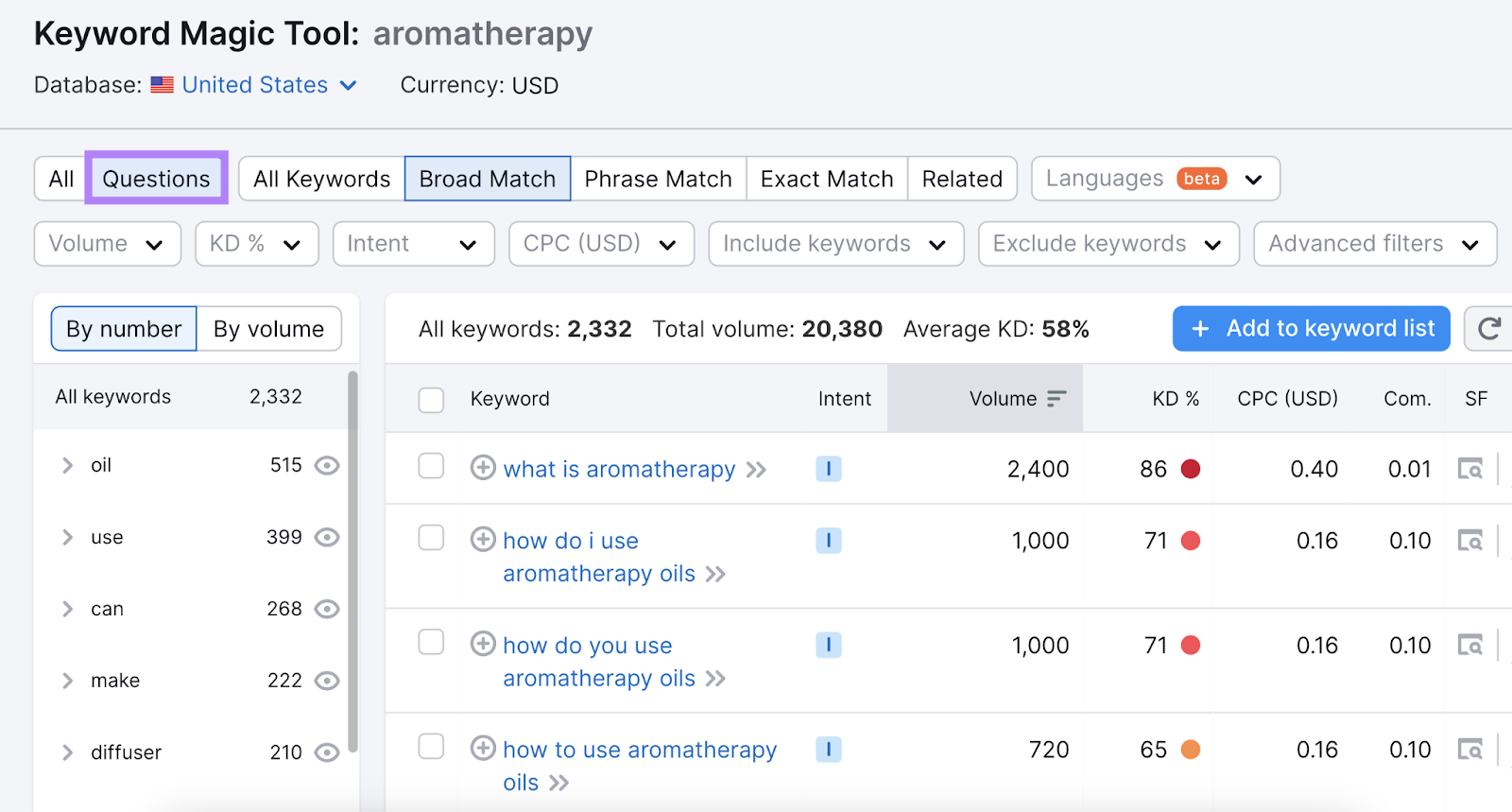
Now, you’ll see a list of related questions to your seed keyword.
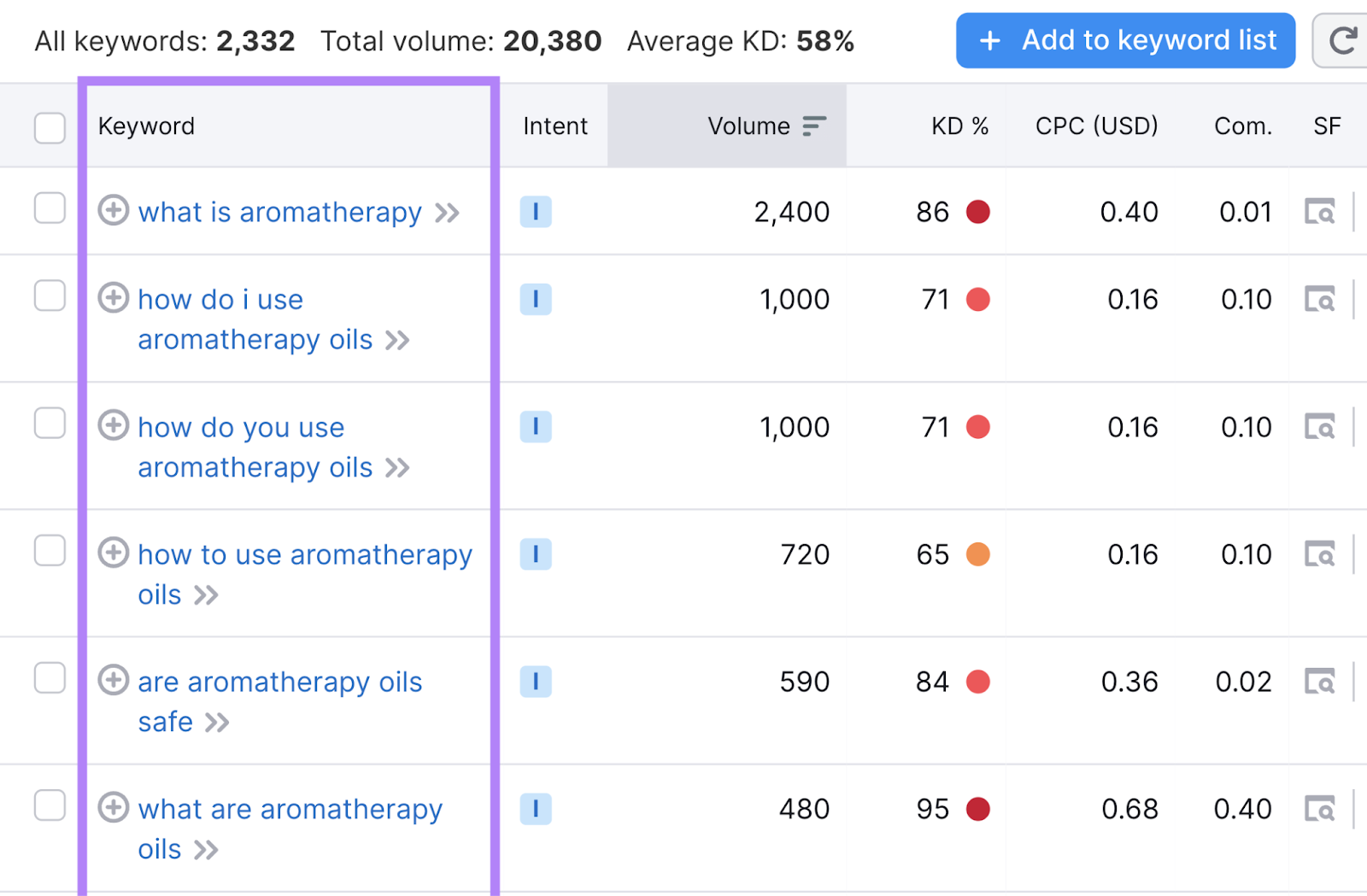
To see questions with lower keyword difficulty, select “Easy” or “Very Easy” from the “KD %” drop-down.
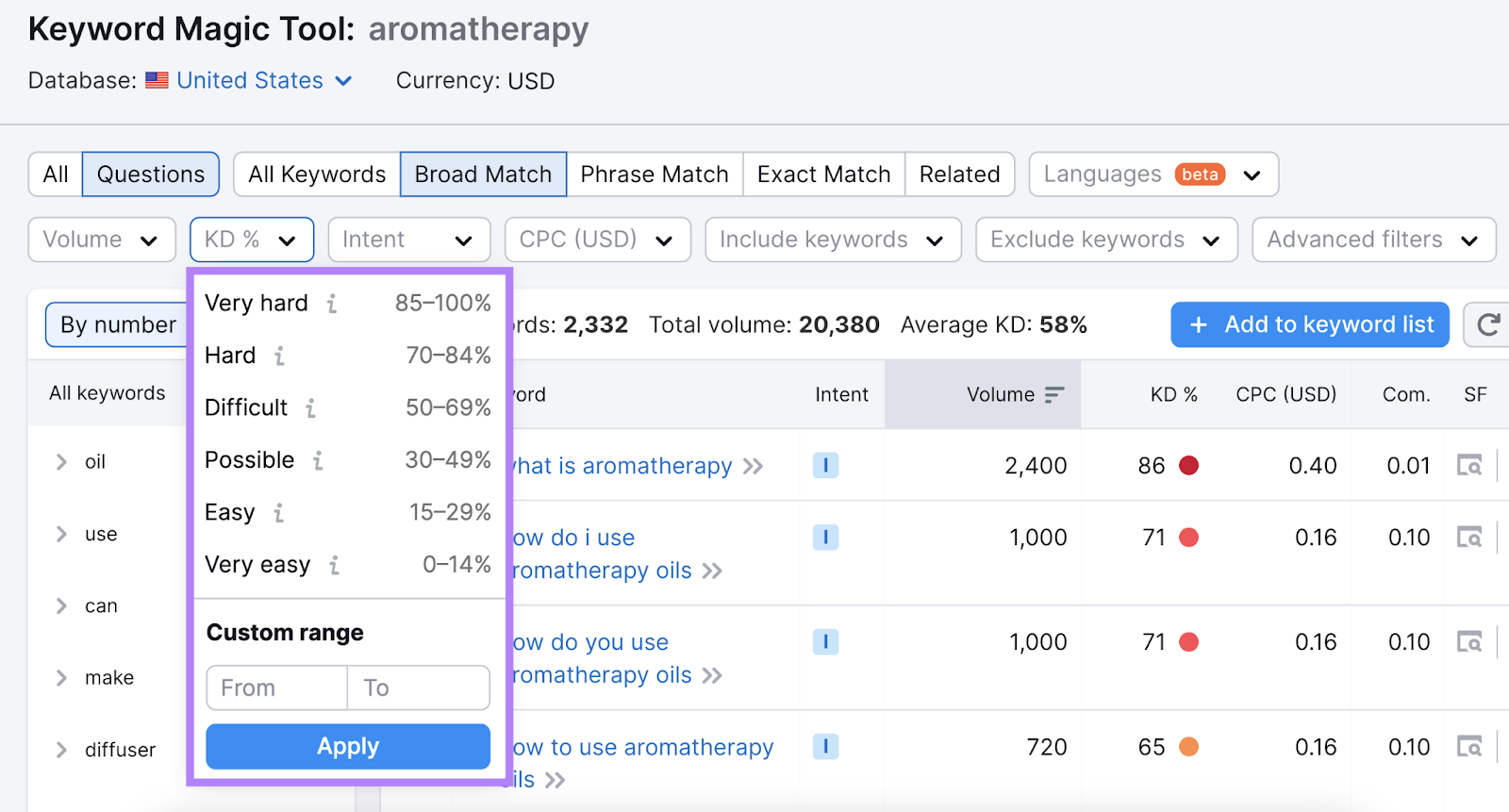
Use the “Intent” and “Volume” filters to eliminate keywords with the wrong search intent or volume for your content.
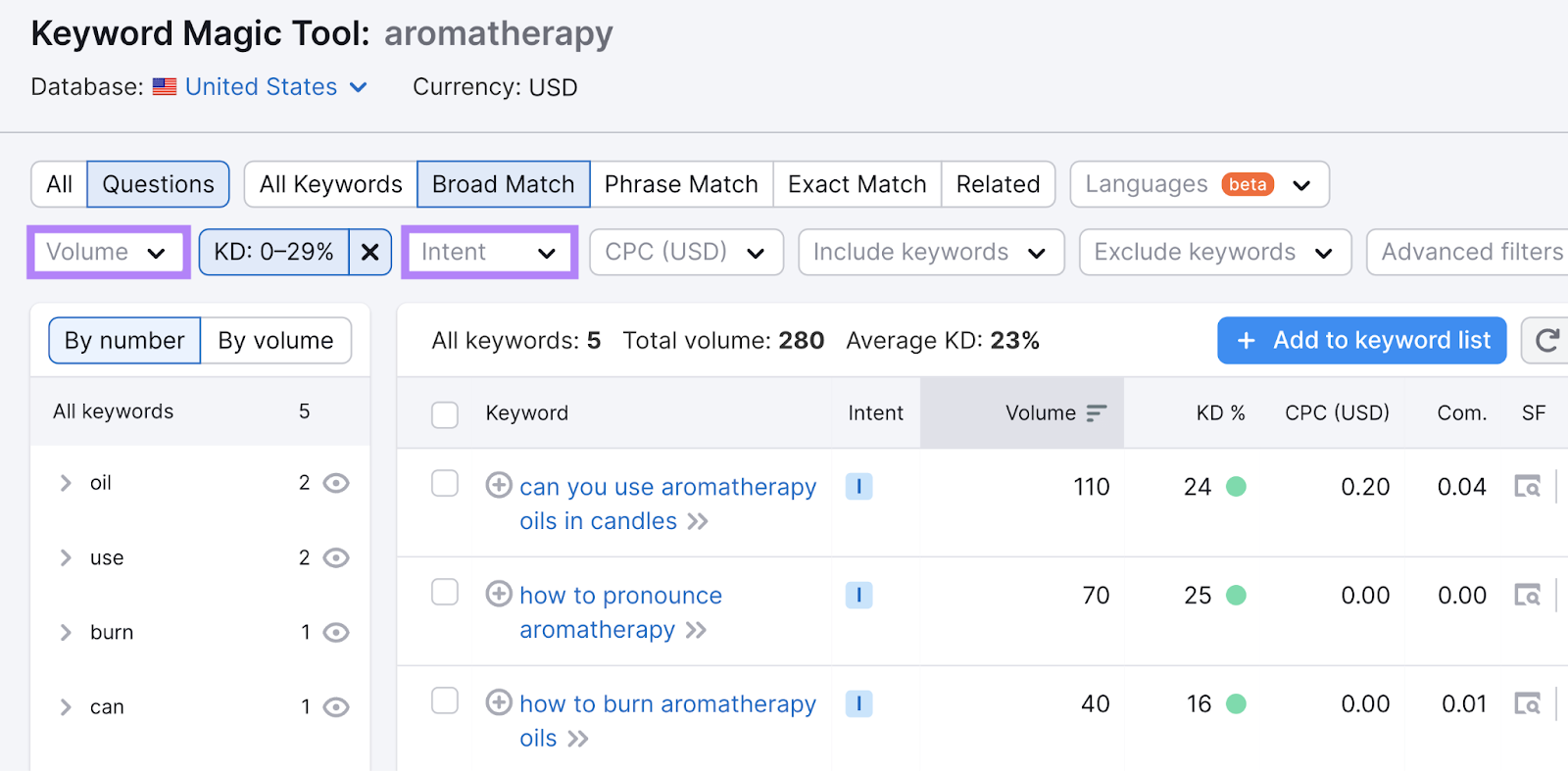
Now, use the keywords or long-tail phrases you’ve identified to guide your content outline.
Include LSI Keywords
Latent semantic indexing (LSI) keywords are keywords that are semantically related to your target keyword’s topic.
Identifying LSI keywords for your outline can be helpful because it can improve your content’s relevance. And chances of ranking.
It can also help you find related topics and questions to address in your content. And determine relevant headings and subheads for your outline.
To find LSI keywords, return to the Keyword Magic tool. And go through the results for your target keyword. Make a list of relevant keywords to find additional topics to cover in your outline.
Another way to find LSI keywords is with our SEO Content Template tool.
Start by entering your keyword (or multiple keywords). Then, select a country and click “Create content template.”
For this example, we’re keeping aromatherapy as our blog topic.
Here, we’ve added some extra keyword ideas to get things started. So, we’ll end up with more semantically related word suggestions.
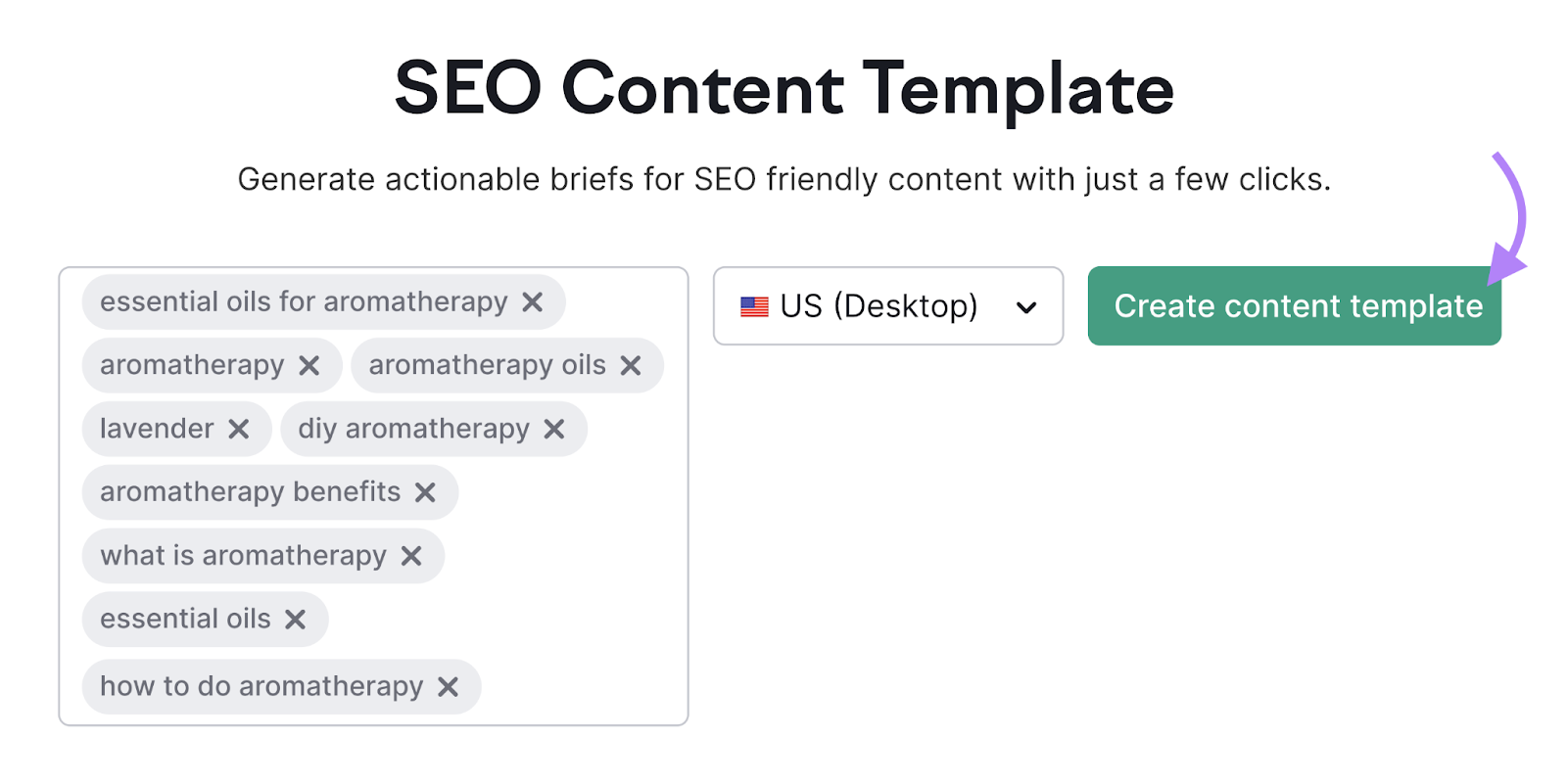
The recommendations provided by SEO Content Template are based on the top 10 results for each keyword you enter. You’ll find the URLs of these results in your report.
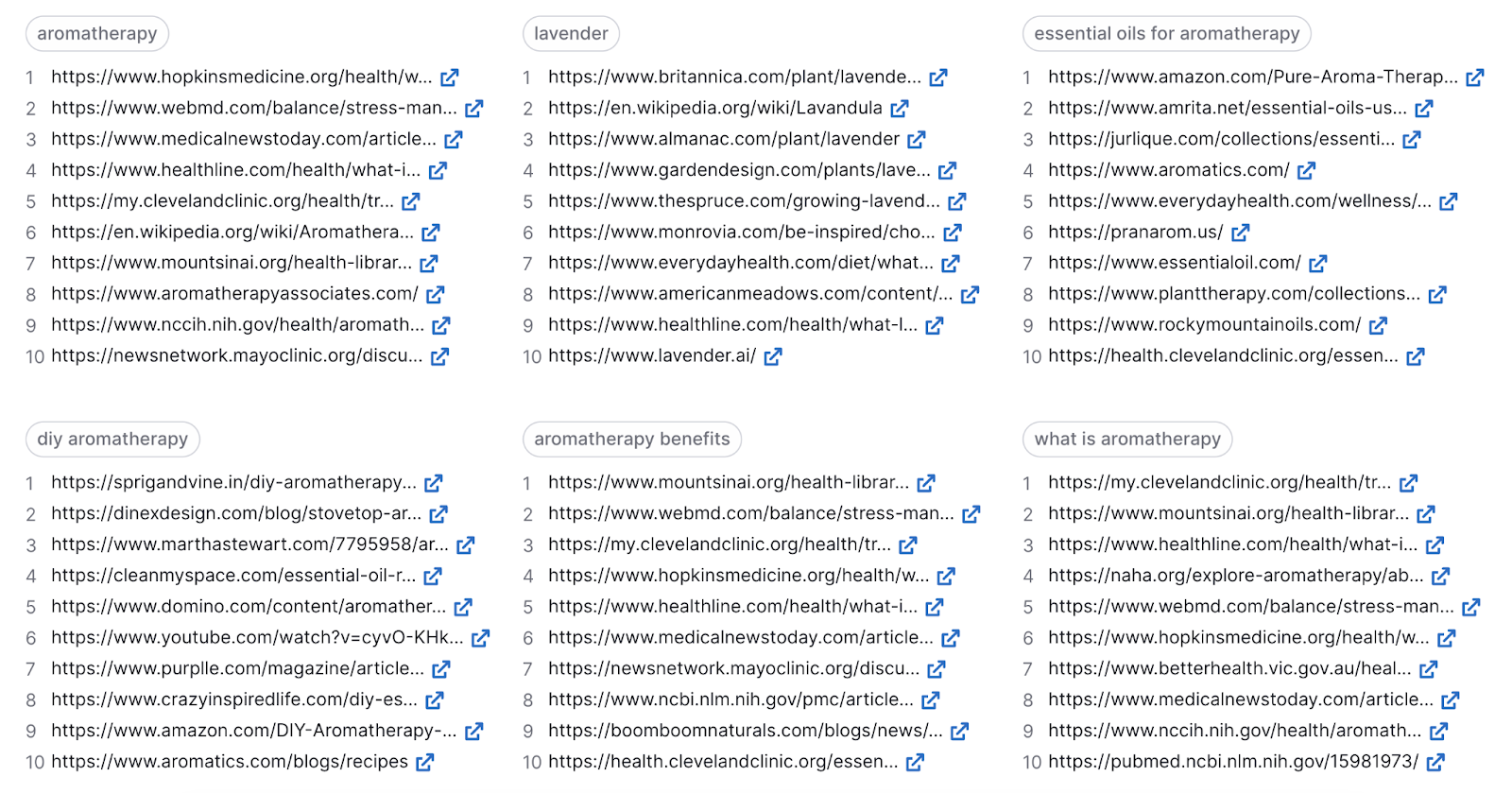
Scroll to “Key recommendations.”
Here, you’ll find a list of recommended semantically related words. And recommendations for text length. And backlinks.
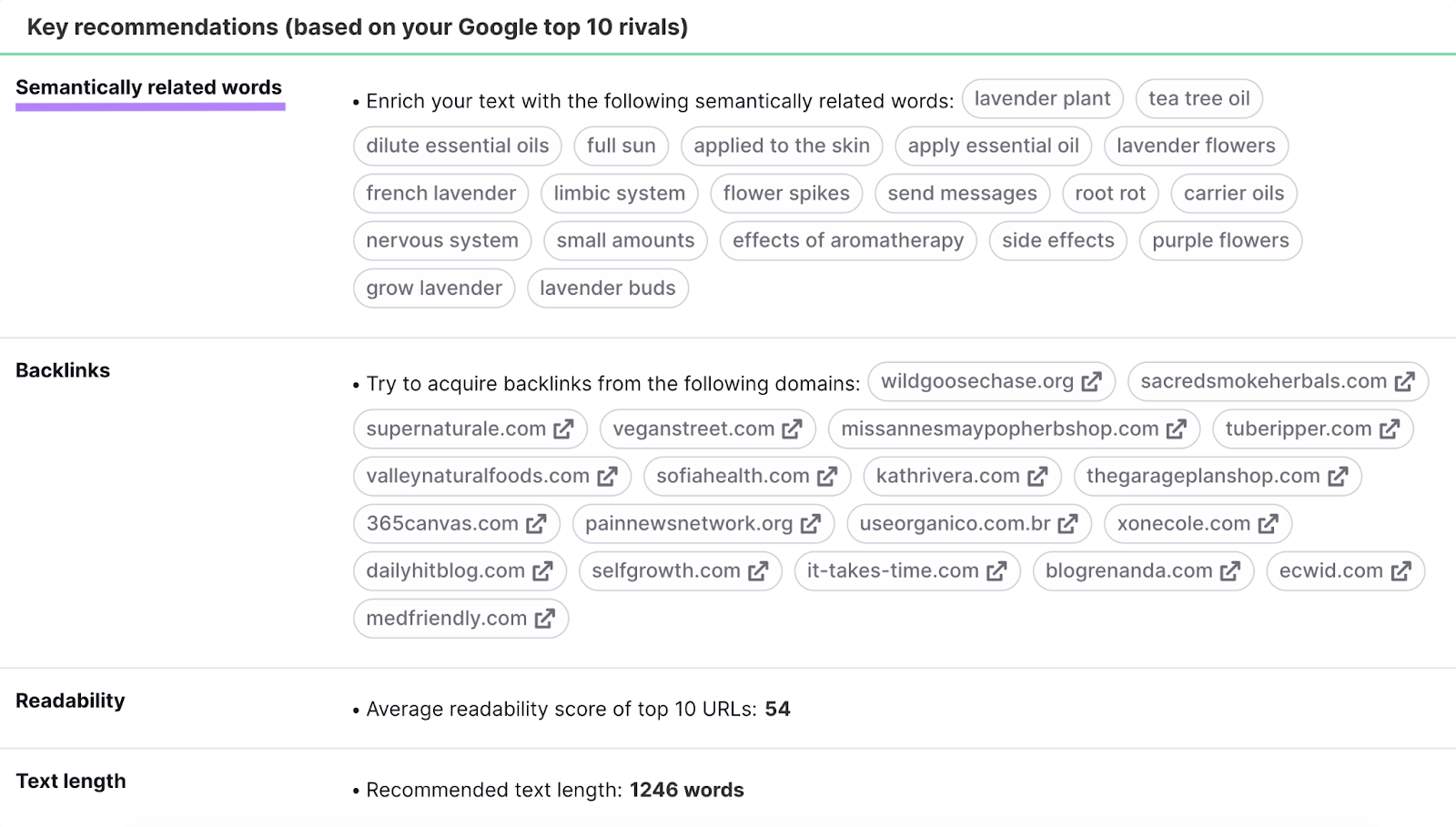
Further down, you’ll see how your top competition has used these keywords. This can help inform your outline’s structure and contents.
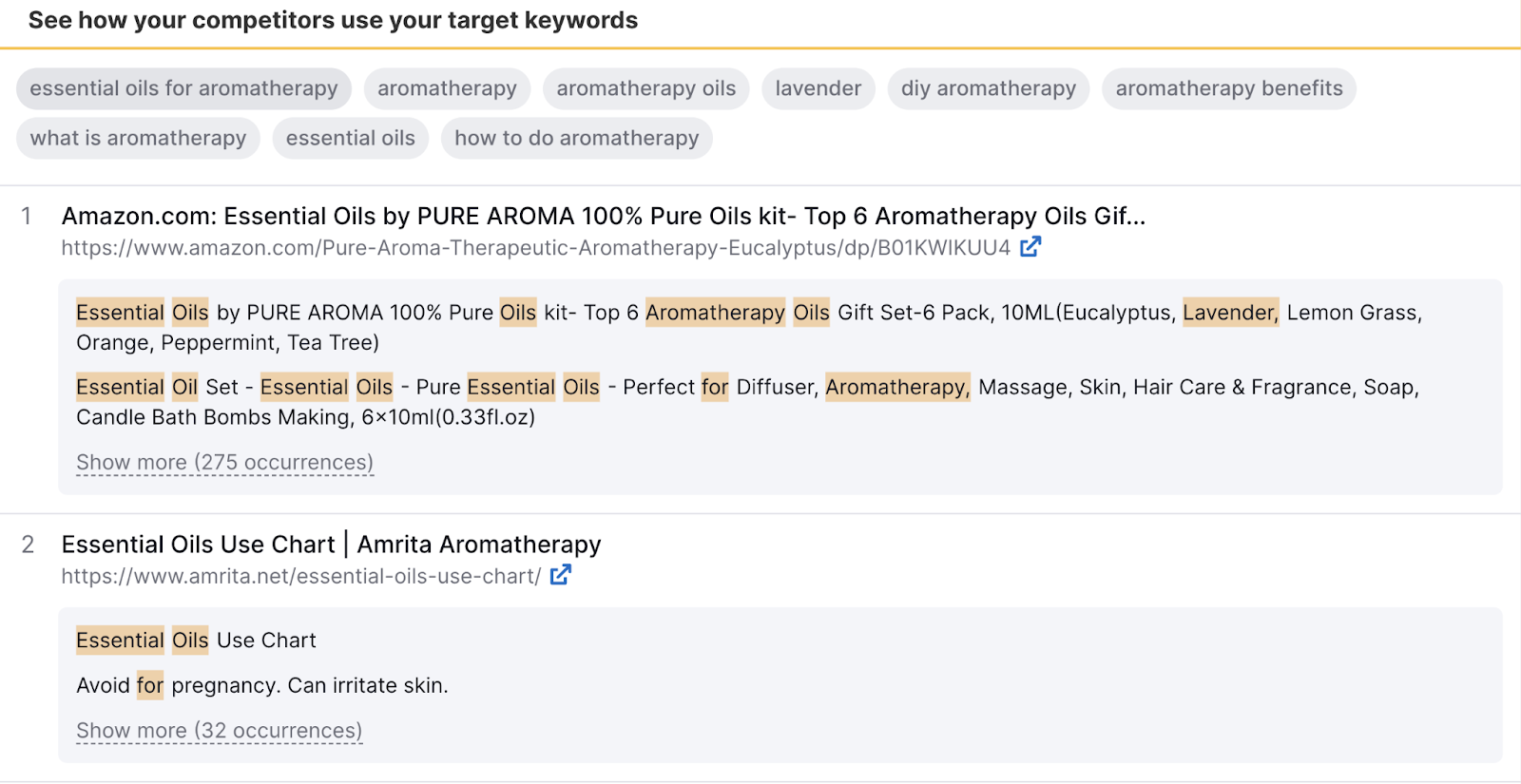
Scroll to the bottom of the page for SEO recommendations to implement in your content. You’ll find tips for your page title, meta description, H1, and article body text.
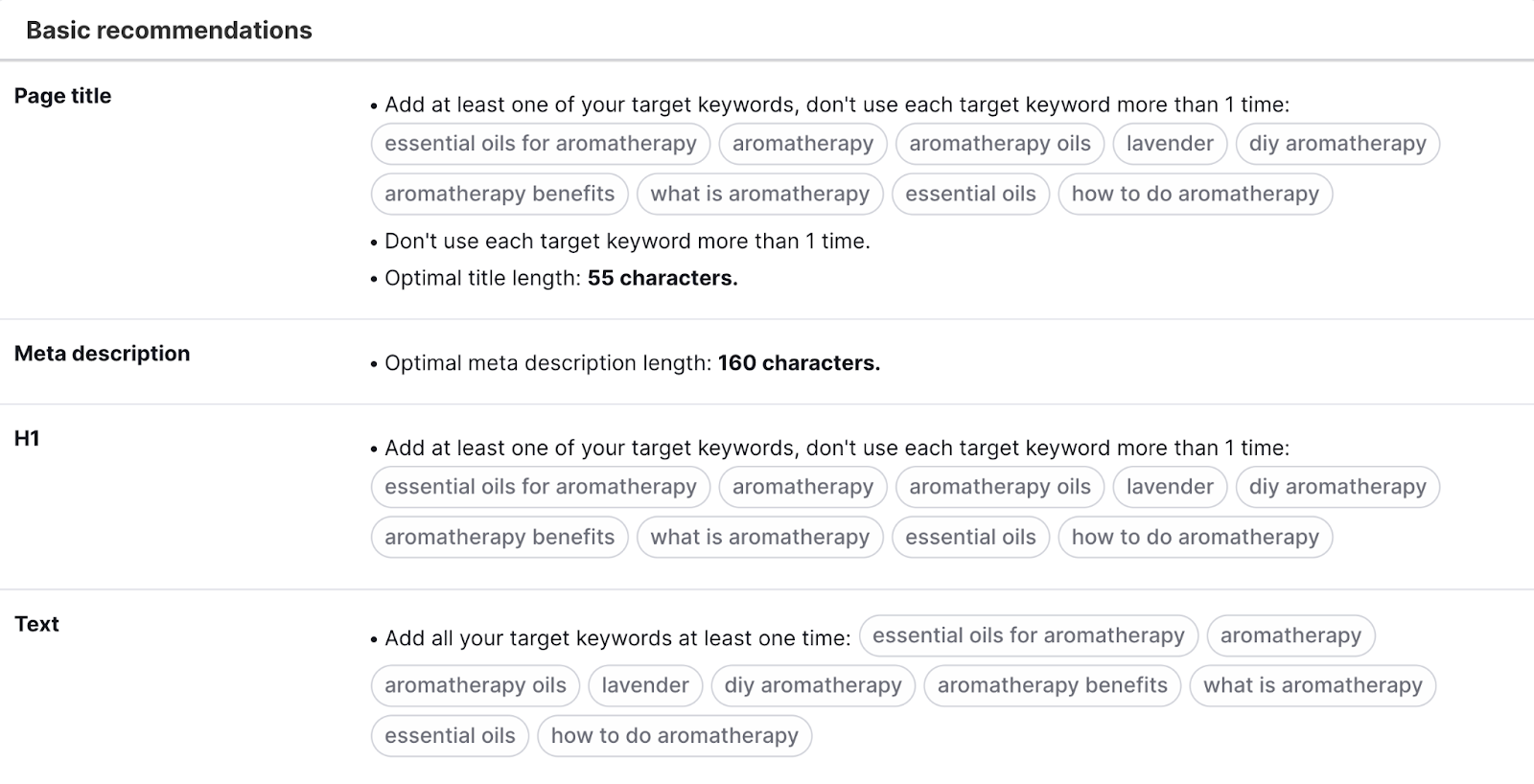
To export these SEO tips as a template, scroll back to the top and click “Export to DOC.”

Create a Content Outline in 5 Steps
1. Research Your Topic
The research phase is a foundational element in crafting your content outline. It involves gathering data, insights, and expert opinions to ensure your content is authoritative. And comprehensive.
Research Industry-Leading Websites and Blogs
Begin by exploring industry-leading websites and authoritative blogs. These sources often provide up-to-**** information and insights into current trends, best practices, and industry standards.
Make note of any recurring themes or topics that could be relevant to your content.
Review Studies and Academic Research
Academic studies and research papers are invaluable resources for data-driven content. They provide in-depth analysis. And can lend credibility to your content.
Look for recent studies that relate to your topic. And save crucial findings to include in your outline.
Collect Quotes and Statistics
As you sift through various sources, collect compelling quotes from industry experts and relevant statistics. These elements can add weight to your arguments. And provide a factual basis for your claims.
As you write your outline, copy/paste the information under the respective subheads for easy reference when you begin writing.
Analyze Competitor Content
Look at what your competitors are publishing. This can give you an idea of what resonates with your industry’s audience.
Note any content gaps. And topics you could cover more comprehensively.
If you need some help coming up with topic ideas to flesh out your content outlines, try our Topic Research tool.
Use it to research common headlines and questions associated with your topic. Simply type your topic into the search bar to discover related subtopics. And content ideas to use in your outline.
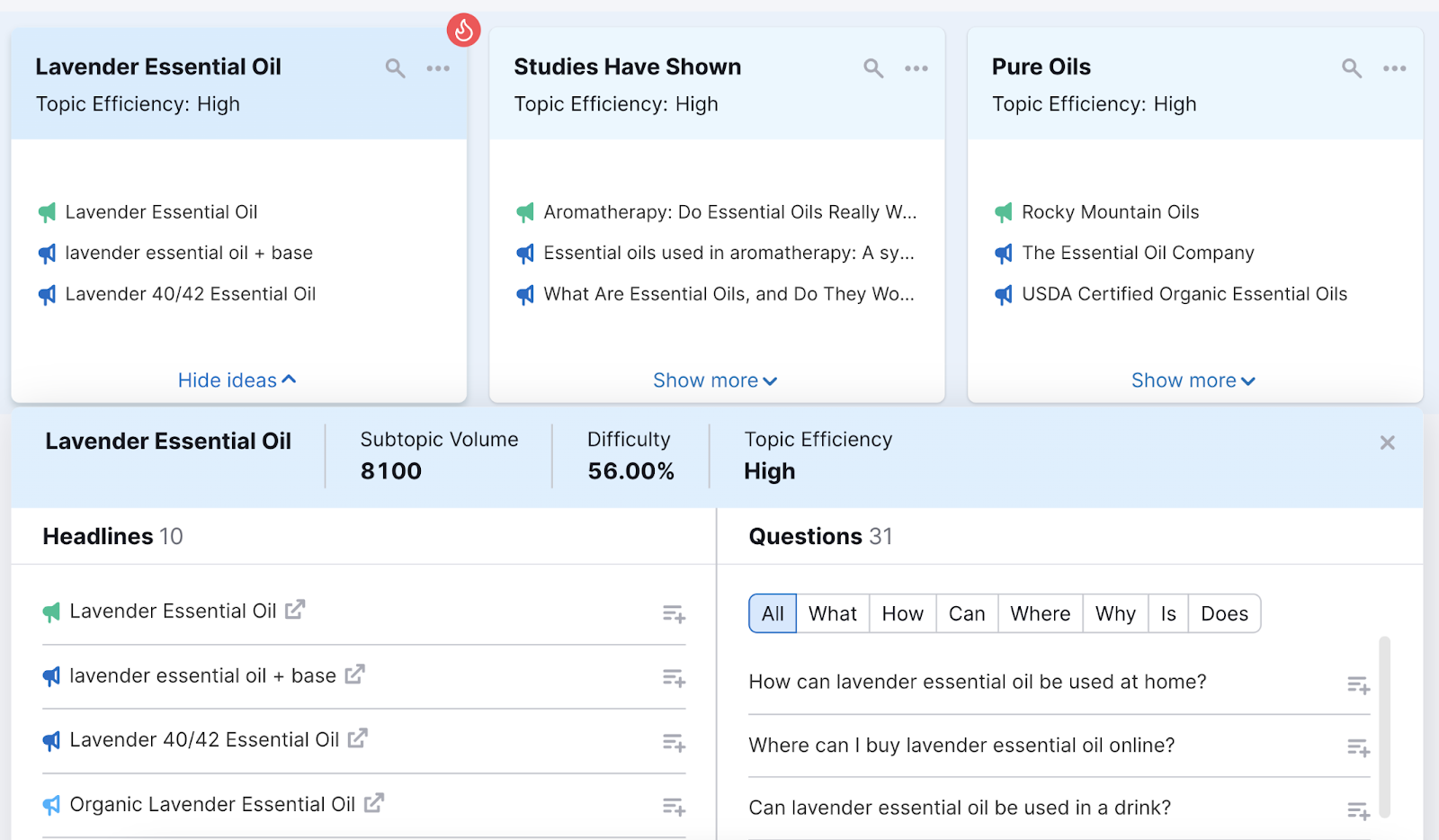
Choose between multiple views. Explore your topic by topic cards. Or with an interactive mind map.
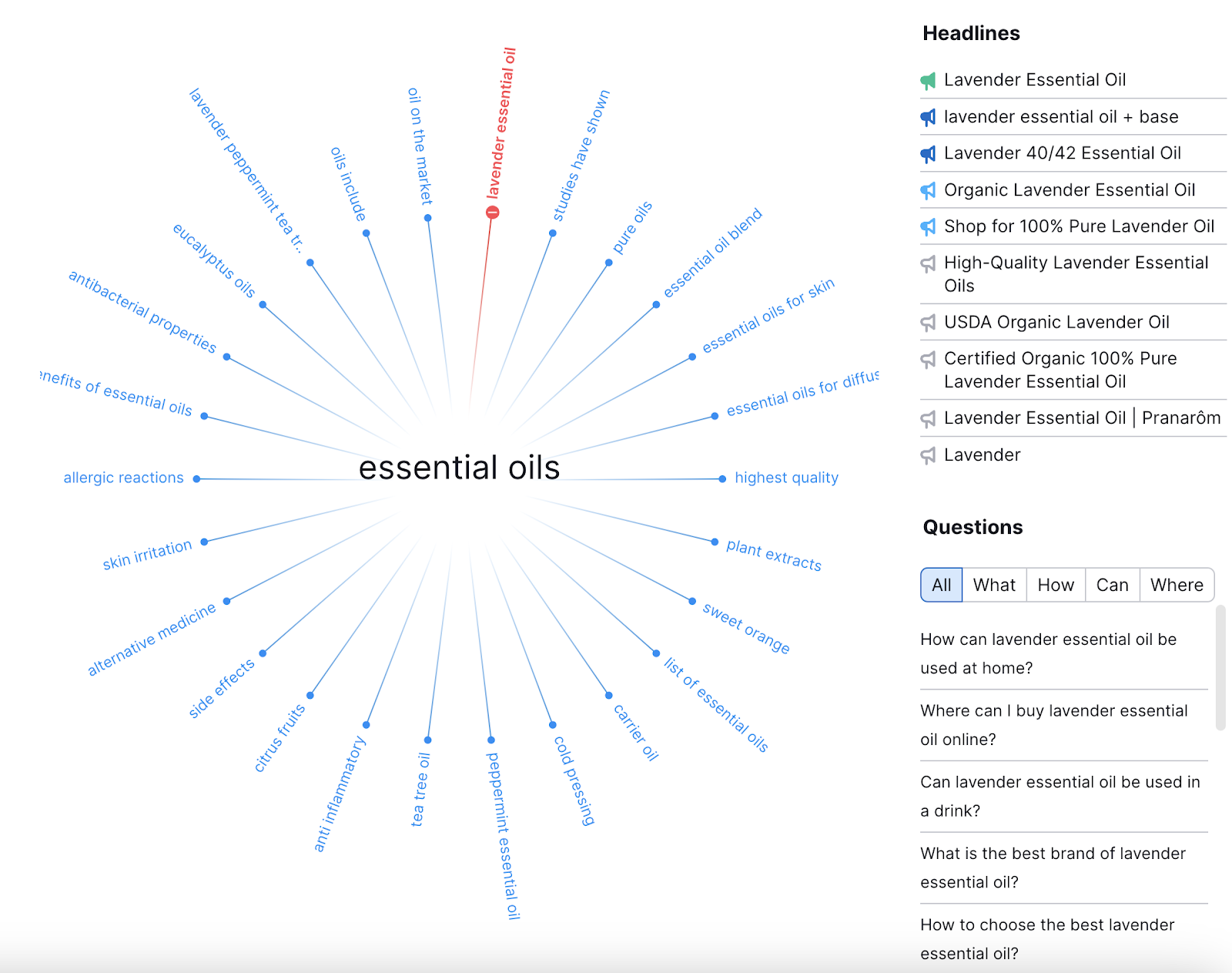
2. Identify Key Points
From your research, distill the most crucial information that aligns with your objectives. These key points will form the main sections of your outline. And will be expanded upon in the final content.
This step is particularly important as it lays the foundation for the structure of your content. It’s here that you’ll decide what topics are essential for achieving your objectives. And engaging your audience.
Think of these key points as the pillars of your content, each one supporting and reinforcing the overall message. They should be clear, concise, and directly related to the goals you’ve set.
By carefully selecting these key points, you ensure every element of your content is purposeful. And impactful.
3. Organize Your Outline with Headings and Subheads
Once you have all your initial ideas and key points documented in one place, start grouping similar ideas into logical sections.
As you do this, think about your main headings.
- Outlines often include multiple H1 options. Write down a few ideas.
- Map out the H2s you’ll include
- Add any applicable subheadings to your outline (<h3> to <h6>) under your H2s
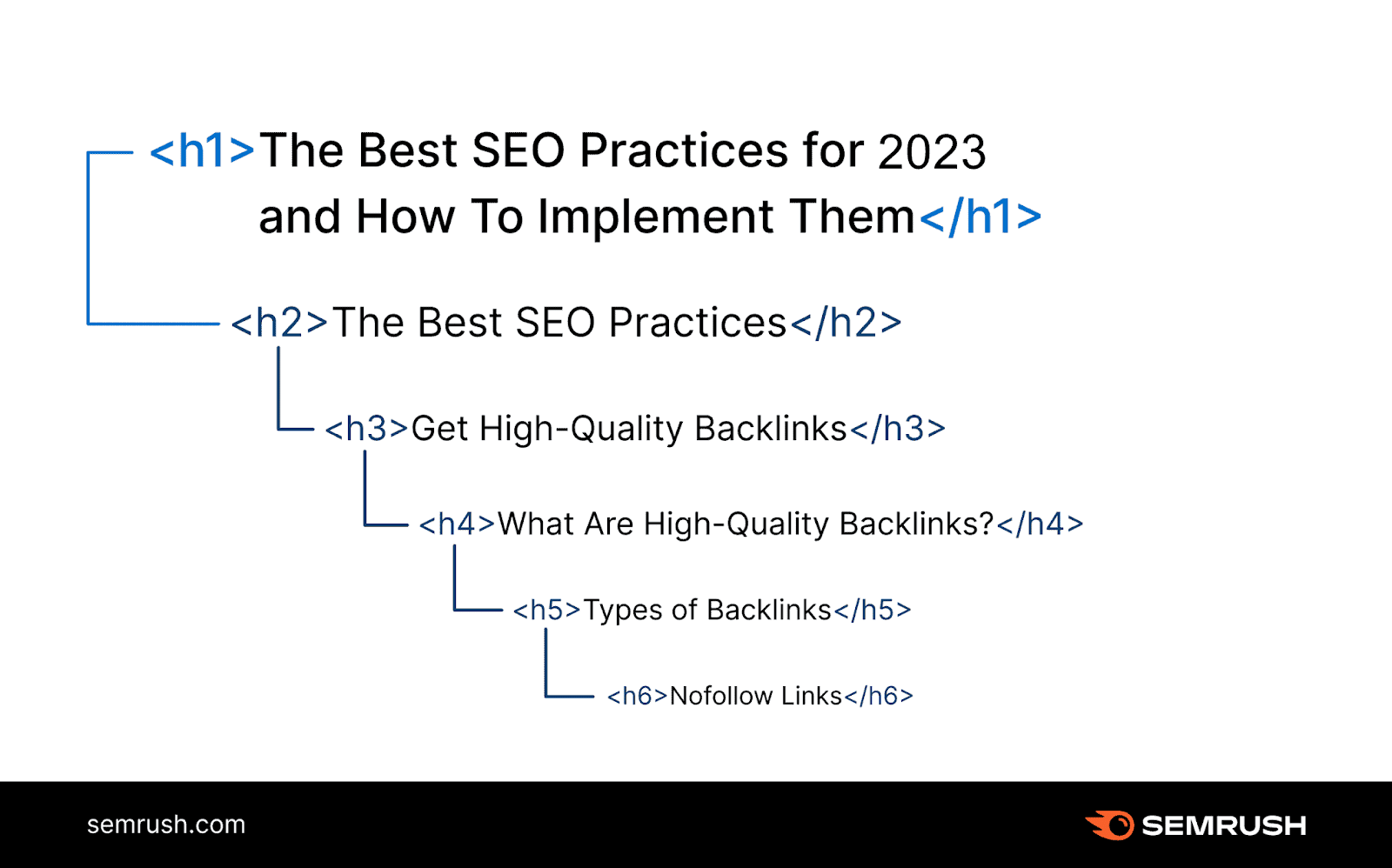
For example, let’s say you’re writing an article about product photography to promote a client’s photo editing software. Based on the top SERPs for the keyword “product photography,” you decide to make product photography tips the main focus of your article.
After researching the topic, you created a mind map with ideas for related topics. And questions you want to cover.
Now, it’s time to organize those ideas into a logical structure and hierarchy.
Your initial outline might look something like this:
<h1> 5 Tips to Improve Your Product Photography </h1>
<h2> What Is Product Photography? </h2>
<h2> 5 Tips for Product Photos That Convert </h2>
<h3> 1. Get the Lighting Right </h3>
<h3> 2. Consider the Backdrop </h3>
<h3> 3. Use a Tripod </h3>
<h3> 4. Take More Shots Than You Think You Need </h3>
<h3> 5. Use the Right Editing Software </h3>
<h4> Photoshop </h4>
<h4> Lightroom </h4>
<h4> Canva </h4>
<h2> Different Types of Product Photography </h2>
<h3> Studio / Hero </h3>
<h3> Flat Lay </h3>
<h3> Lifestyle / Process </h3>
<h2> Conclusion & CTA </h2>
3. Refine Your Outline for Clarity and Flow
Read your sections and headings aloud to ensure they have a logical flow.
At this stage, you might realize that the initial order of some of your sections doesn’t make sense. Move them around until the piece flows logically.
Or, you might find issues in your outline’s information hierarchy. And decide you need to add subheads.
Looking back at our product photography example, we might move the <h2> “Different Types of Product Photography” up before the “Tips” section. To introduce this information earlier in the article.
And, considering the goal of the article is to promote the client’s photo editing software, we might decide to make a new <h2> heading about editing tools. This way, we can cover the topic in much greater detail than if we kept it as an <h3> heading.
<h1> 5 Tips to Improve Your Product Photography </h1>
<h2> What Is Product Photography? </h2>
<h2> Different Types of Product Photography </h2>
<h3> Studio / Hero </h3>
<h3> Flat Lay </h3>
<h3> Lifestyle / Process </h3>
<h2> 5 Tips for Product Photos That Convert </h2>
<h3> 1. Get the Lighting Right </h3>
<h4> Using Natural Light </h4>
<h4> Positioning Your Key Light </h4>
<h3> 3. Use a Tripod </h3>
<h3> 2. Consider the Backdrop </h3>
<h4> Backdrop Types </h4>
<h4> Positioning Types </h4>
<h3> 4. Take More Shots Than You Think You Need </h3>
<h3> 5. Retouch Your Photos </h3>
<h2> Choose the Right Photo Editing Software </h2>
<h3> Client’s Photo Editing Software </h3>
<h3> Photoshop and Lightroom </h3>
<h3> GIMP </h3>
<h3> Canva </h3>
<h3> Pixlr </h3>
<h2> Conclusion & CTA </h2>
5. Add Notes or Instructions under Your Headings
Under each heading, build out your outline by adding more details about what you have in mind for that section.
- What are the main points you want to communicate?
- What information do you want to cover in this section?
- Are there specific sources you want to consult?
- Any internal links to include?
- Product or feature mentions or CTAs?
Include specific, detailed directions. Whether you’re writing the content yourself or handing it to a writer, editor, or client. These instructions provide context that helps streamline the writing process.
Returning to our product photography example, your outline might look like this after adding your notes and instructions:
<h1> 15 Tips to Improve Your Product Photography </h1>
[Short intro]
Notes: ~150 words. Talk about how you don’t need photography experience or professional equipment.
<h2> What Is Product Photography? </h2>
Notes: Describe the defining characteristics of product photography. Why do quality product photos matter (mention the impact on sales and cite stats). Is it different from other types of photography? How? Mention emphasis on different equipment, e.g., artificial lighting and tripods.
Further reading: The Ultimate Guide to Creating a Content Marketing Strategy
Elevate Your Content Outlines with Semrush
Content outlines make it easier and faster to write high-performing content. While research is a vital step in the process, understanding your audience, identifying keywords, and analyzing competitors will elevate your outlines—and your content.
Sign up for Semrush today to access everything you need to create outstanding content for your target audience.
Source link : Semrush.com
